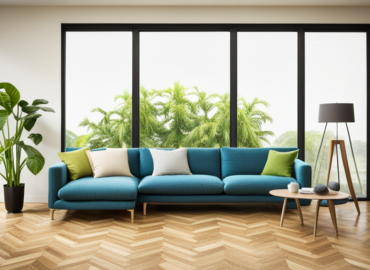What Should Be My House Humidity?
Maintaining optimal humidity in our homes isn’t just a comfort issue; it’s pivotal for our well-being and the longevity of our wood furnishings and structural integrity. If you’ve wondered ‘what should the humidity be in your house,’ or struggled with the results of unbalanced moisture levels, then you’ve come to the right place.
Whether it’s dry, itchy skin in winter, or the oppressive mugginess of summer, getting to that proper humidity for home environments is essential. The difference between feeling cozy or combating colds can hinge on this crucial balance. In this comprehensive guide, we’ll dissect the nuances of home humidity and its profound effects on our lives.
Understanding Home Humidity
When we discuss optimal humidity in house, we typically focus on temperature settings, pushing humidity to the backseat. However, our comfort and the energy efficiency of our homes rely heavily on maintaining the right balance of moisture in the air. It’s surprising how often it’s overlooked, yet so fundamental to our daily living environment.
- Seasonal Variations in Humidity: In our quest for proper humidity for home, it’s imperative to understand that the ‘ideal’ is a moving target with seasonal shifts. In the piercing cold of winter, we should aim to keep indoor humidity levels between 30-40%. As we thaw out into summer, that range elevates to a more tropical 50-60%. This seasonal dance is not just about comfort; it’s a proactive measure against various humidity-induced issues.
- The Summer Struggle: High humidity, when escorted by high temperatures, brings forth a sweltering sensation known as the humidex effect. It’s not just about the oppressive heat; such conditions are ripe for mold and dust mites to thrive. We often turn to our air conditioning units, relying on them to strike the delicate balance between cool and dry. Yet, an oversized unit might leave us in a chilly but clammy climate – hardly the optimal humidity in house we desire.
- The Winter Woes: On the flip end, winter’s dry spell brings its own set of challenges. You might notice the static cling in your hair or the sudden shock when you touch a doorknob. Chapped lips and nosebleeds become a nagging norm. These are the markers of air too dry for comfort, signaling a drop below what should the humidity be in the house.
To measure and manage our home’s moisture, technology gifts us with tools like humidistats and hygrometers. Humidistats, accompanied by furnace humidifiers or taking up a sentinel’s post on the wall, control our home’s humidity levels, while hygrometers are the inexpensive scouts, reporting back the moisture levels for us to take action.
- Home Humidity Influencers:
-
- Ventilation: Properly venting moist air out of areas like kitchens and bathrooms is crucial, as is ensuring that living spaces are adequately aerated.
- HVAC Systems: They play a chief role in managing the humidity levels, with the thermostat being the director of the operation.
- Home Structure: Insulation and moisture barriers are the silent guardians against humidity extremes.
- Behavior and Environment: Every shower we take, every plant we water, contributes to the indoor humidity—often without us even realizing it.
It’s worth noting that maintaining the ideal humidity for a home is a balancing act that concerns not only comfort but health. High indoor humidity can have invisible yet tangible effects on your health and home, encouraging a host of unwelcomed issues like allergens and property damage. Conversely, what should the humidity level be in house if it’s too low? It can sap moisture from our bodies and our wooden treasures alike.
Lastly, to keep our decks in check in this humidity game, we have a tactical team at our disposal – dehumidifiers, weatherstripping, caulking, and moisture-absorbing materials. And let’s not forget the importance of surveillance; regularly checking for leaks and water damage is crucial in the fight against unwelcome moisture. With rigorous monitoring and corrective action, we not only protect our dwellings but also safeguard our wellbeing, ensuring what should your humidity be in your house remains precisely where it needs to be for ultimate comfort.
Ideal Humidity Levels for Your Home
In our endeavor to achieve the optimal humidity in house, understanding and maintaining the recommended indoor humidity levels is paramount:
- Winter Recommendations: We should keep the indoor humidity levels between 30-40% during the frosty months. Not only does this help in managing the dryness associated with the cold but also aids in preserving the condition of wood furniture and building materials.
- Summer Guidelines: As the mercury rises, so does the humidity, and our homes should ideally stay within the 50-60% range. This ensures a barrier against the proliferation of molds and dust mites, and sustains a zone of comfort devoid of that sticky, muggy feeling.
Monitoring humidity is a continuous task, easily managed with the help of gadgets like humidistats and hygrometers. We should place a hygrometer in a central living space, away from any moisture-generating spots like the kitchen or bathroom to obtain accurate readings. Here goes how I keep an eye on and maintain the right levels:
- Dehumidify or Humidify: I use a whole-home dehumidifier to counteract the cloying summer air. During dry winters, a humidifier is my go-to appliance, ensuring that each breath I take is neither too biting nor too arid.
- Routine Maintenance: Regularly checking on my HVAC system, as well as my home’s insulation, ensures optimal performance without spikes in power bills.
I’ve noticed the tangible benefits of maintaining ideal humidity for a home. It’s not just about achieving a proper humidity for home environments but also about safeguarding our health and welfare:
- Health Perks: Keeping humidity between 40-60% and the temperature at a cozy 65 degrees Fahrenheit creates a sanctuary for restful sleep, and helps prevent issues like asthma attacks and allergies.
- Property Preservation: By staying vigilant to what should humidity level be in house, we prevent warping or cracking in wood floors and furniture.
To wrap up the section without a concluding note, as we navigate the sweet spot of what should the humidity be in the house, the health of our abodes and our own wellbeing thrive in tandem. Following the guidelines from trusted sources such as Health Canada can make this balance manageable and sustainable throughout the year’s changing seasons. Regular surveys for leaks or water intrusion are critical, as is the strategic use of moisture-absorbing materials and consistent HVAC surveillance. It is through these diligent efforts and the assistance of modern technology that we can enjoy the comforts of ideal indoor humidity.
Harm of Improper Humidity Levels
Venturing beyond the recommended range of optimal humidity in house can be an invitation to a plethora of problems that threaten both our home’s integrity and our health. Dealing with too high humidity levels, especially above 50-60%, is a common battle in basements and poorly ventilated spaces. This excess moisture serves as a breeding ground for mold and mildew, both notorious for their health risks and their talent for accelerating structural damage. Our battle against humidity is not just about comfort; it’s also about preserving the air quality we rely on every day.
On the flip side, when we face the dryness of winter months, low humidity levels can fall below the 30-40% mark. Here’s how the arid conditions can affect us:
- Personal Health: Constant exposure to dry air can leave us with uncomfortably dry skin and increase the likelihood of nosebleeds. What’s more, respiratory issues can flare up, creating an uncomfortable living environment. Even hydration comes into play, as low humidity has a propensity to draw moisture from our bodies, leading to dehydration.
- Home Hazards: The static electricity that seems a harmless nuisance can, in fact, cause substantial damage to sensitive electronics. It’s a little-known consequence of what should humidity level be in house not being properly managed.
To strike the fine balance within the sweet spot of that ideal humidity for a home, the strategies differ based on the extremity we’re facing. Should the humidity climb too high, combating this includes:
- Air conditioning and dehumidifiers to wrestle the moisture levels back down.
- Utilizing exhaust and ventilation fans, especially after showers or while cooking, to whisk away the excess humidity.
- Attending to any leaks that contribute to the moisture problem, coupled with smart thermostats to regulate conditions optimally.
- Introducing certain houseplants known for their dehumidifying properties, such as peace lilies or Boston ferns.
Conversely, boosting humidity during the parched months involves tactics like:
- Allowing clothes to air dry indoors, where they release moisture into the air.
- Foregoing the drain immediately after a hot bath or doing dishes, letting the steam serve as a natural humidifier.
- Selecting the right plants, such as areca palms or rubber plants, can subtly increase indoor moisture.
By incorporating hygrometers throughout various areas in the house, we can effectively monitor real-time humidity levels. This allows us to respond swiftly with appropriate measures, ensuring that proper humidity for home is maintained, and we preserve the robustness of our dwelling. In taking these actions, I ensure not only the longevity of the physical structure of our house but also the safeguarding of our family’s well-being—maintaining the optimal humidity in house where life unfolds daily.
How to Achieve and Maintain the Right Humidity
Achieving the right balance of humidity in your home, where the sweet spot lies between 30% and 50%, significantly impacts our comfort and health. I’ve identified a suite of strategies to aid in the regulation of our home’s atmosphere:
Increasing Humidity for Winter Comfort
- Indoor Flora: Introducing houseplants like palms, philodendrons, and Chinese evergreens can naturally increase indoor humidity, plus they freshen the air with a touch of green.
- Boiling and Cooking: Boiling water and using the stovetop for cooking release moisture into the air, acting as an impromptu humidifier during those parching winter months.
- Humidifiers: Using a humidifier, particularly whole-home systems like those from YORK®, is the most effective tool for adding moisture. Tying one into your furnace allows for a uniform distribution of humidity across every room, ensuring the proper humidity for home is achieved.
To maintain this balance, a hygrometer is essential, providing real-time monitoring of in-house humidity and ensuring optimal humidity in house is sustained.
Reducing Humidity for a Fresh Summer
When summer humidness encroaches, bringing along a muggy discomfort, I prioritize several key actions:
- Dehumidifiers: Portable or whole-home dehumidifiers methodically filter the moist air, cooling it down to produce clean, dry air, effectively controlling what should the humidity be in your house.
- Ventilation: Exhaust fans in the kitchen, bathroom, and laundry areas absorb the dampness, transporting it outside. Additionally, cooking outdoors when possible avoids internal humidity spikes, promoting optimal humidity in house during the steamy season.
- Preventive Measures: Ensuring the plumbing is leak-free, keeping surfaces dry, and attending to any structural cracks help prevent conditions that invite excessive humidity and the consequent formation of mold.
For modern homes with tighter seals, integrating an Energy Recovery Ventilator (ERV) can replenish indoor air without the energy loss associated with traditional window opening.
Maintaining the Ideal Year-Round Levels
These strategies play a pivotal role in the pursuit of what should humidity level be in house:
- Invest in smart AC controllers: Many air conditioners don’t automatically manage humidity, but smart controllers can set and maintain desired levels.
- Regular Inspections: Continuous checking for insulation integrity and fixing any wall cracks or leaks goes a long way in maintaining ideal humidity for a home.
- Air circulation and Regulation: Ceiling fans are not just for cooling; they help dehumidify by improving air circulation. Monitor and regulate using thermostats and humidistats to keep what should your humidity be in your house right on target.
By employing these tools and tactics, I’m able to adjust my home’s humidity, ensuring optimal conditions for both well-being and the longevity of our living spaces. Whether we’re cooling down in the summer heat or warming up against the bitter cold, knowing what should humidity be in house is pivotal. Regular vigilance and timely adjustments can make all the difference in crafting a comfortable, healthy living environment.
Conclusion
In conclusion, the journey to maintaining optimal humidity levels in our homes is essential for our comfort, health, and the preservation of our indoor environment. From understanding the significance of seasonal variations to employing the right tools and strategies like hygrometers, HVAC systems, and dehumidifiers, we’ve explored the delicate balance that must be struck. It is with these insights and actions that we can sustain the recommended humidity levels of 30-50%, creating a harmonious living space conducive to well-being and the safeguarding of personal and property health.
The implications of our discussion extend far beyond mere comfort. They inform our daily decisions, impact the efficiency of our homes, and influence our health outcomes. As we close this comprehensive guide, remember that the key to achieving and maintaining ideal indoor humidity lies in consistent monitoring and proactive adjustments, thus ensuring our abodes remain a sanctuary throughout the seasons. Let us embrace the tools and knowledge at our disposal, and strive for the perfect balance of moisture in our lives.



